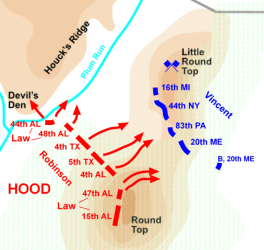After stepping off from the Bushman Woods and crossing over a short lane which we now know as South Confederate Avenue, the brigade started up the heavily forested southwestern slope of Little Round Top (LRT). As they got into the trees, Law detached the 47th and 44th from the extreme right side of the brigade line and had them countermarch behind the brigade and assume new positions well to the left of the 4th Alabama.
Depending on whom you believe, this detachment occured either (1) because the 47th and 44th were encountering especially rugged wooded terrain that threatened to break up their unit congruity; or (2) because there was a call for Robertson's Brigade (Texans), probing near Devil's Den, to be reinforced.
Robertson, and Benning's Brigade (Georgians) to his immediate left, had encountered heavy Union resistance as they climbed the ridge behind the Triangular Field, and then nearly came apart with the counterattack of the 124th New York ("Orange Blossoms") across that same field. This was about the time that Hood was wounded and division command passed to Law. It's not impossible that Law learned of the threat and passed along his two far-right regiments to bolster Robertson. According to his post-war writings, Hood claimed that his intent was to move Law up into the woods of LRT, out of sight of the 4th Maine and other Union defenders at Devil's Den, and then to sweep down upon them across the Plum Run valley and take them in flank. It was never foreseen to achieve the apex of LRT and then clamber down onto the Taneytown Road into the Federal reserve.
Post-war revisionists fixated on the effect such a move might have made on the Union "fishhook", although they ignored the fact that much of Sykes' Fifth Corps and all of Sedgwick's Sixth Corps were held in the Union reserve, and might easily have been marched to stop the Union army from being rolled up. Even though Law and Hood (and especially Law and Longstreet) had clashed over tactical matters in the past, it appears that Law was still sticking to Hood's plan, even though he was shorting the flanking force by two full regiments. Of course, no one expected Vincent's Brigade (incl. 20th Maine) to be in a defensive position on the southern slope of LRT. In fact, Law expected no resistance as his right-most regiments climbed the hill. Oates and the 15th Alabama were surprised by the first volleys from the 83rd Pennsylvania and 20th Maine...then got into the spirit of the fight, as countless historians have described ad nauseum.
So, if Law had not stripped two regiments off his brigade front, what would've happened? As we all know, Chamberlain was hard-pressed to keep a defensive position against the 15th and 48th Alabama, even having to refuse his left flank at one point. If the 48th and 44th Alabama had comprised the far right of Law's line, there is little doubt that the 20th Maine would've been flanked and routed. Certainly, there wouldn't have been any last-ditch heroic bayonet charge. But, in the end, would it have even mattered?

